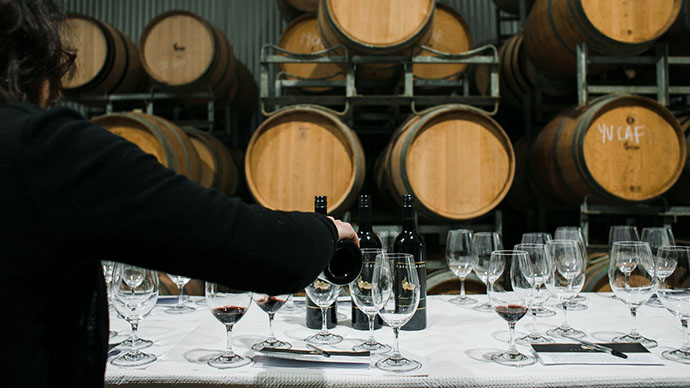Wine is often considered one of the essential items for a perfect dinner party. It is important to learn about the different types of wines, and what kind(s) would be good with what you are serving. Many people love to drink wine. But many others are confused about what kind of wine to buy or what to do when they are drinking it. Due to its sophistication, learning about the wine tasting etiquette and workings of a wine tasting dinner has become a culture of its own.
Wine Tasting Dinner: Food and Wine Pairing.
It can be difficult to find the right food and wine for your guests when looking online and seeing all the experts weigh in. We’re here to help simplify if you feel lost among the critics talking about oak undertones and tannin levels. It should not take hours of research to plan the perfect dinner.
Best Practices for Wine Selection.
What are you going to do to pair wine with food?
You need to remember that the wine you choose needs to match the intensity and flavor of your food. Red wine and meat are better with each other. Light-intensity meats will be better with white wine. The wine and food richly complement each other. You should serve wine that is more acidic than the food you are serving and sweeter than the meal. Wine tasting can be very subjective, and you should choose one based on what you enjoy. It’s pointless to use a “critic-approved” option if you know it goes against what everyone in the room wants.
Appetizers and Wine Pairing .
It is time to look at the details after you have learned the basics of wine picking.
Appetizers are a great way to start a party and keep hungry guests at bay and give you more time to prepare dinner. It is possible to keep it simple and just pair together some wine and cheese, but there is room for more creativity. It works well to pair sparkling wine with crisp, fried, or spicy bites, white unoaked wine with spicy snacks, and Rosé with middle road apps.
Food and Wine Pairing Ideas.
You may want to skip the wine with appetizers and save it for the main course. That way, the stakes are higher. With so many menu options, how exactly can you decide on what to pair with red wine or rosé? Once more, this is where keeping the basics covered in mind is important. Just remember there isn’t a right or wrong choice, especially if you simply choose a wine that fits the palate of your guests. Pairing wine with dinner is easy when you know these simple rules. Use them as a guideline to help you find the perfect wine for any occasion.
Dessert Wine Pairing Ideas.
It is time for you to end your dinner with a dessert. There are five types of dessert wines that you can choose from, and they all work well with the main course.
- Sparkling
- Lightly Sweet
- Richly Sweet
- Sweet Red Wine
- Fortified Wine
This is one of the keys to success. You have to pick a type of ice cream that goes best with the fresh dessert you will make.
Some people like chocolate, vanilla, or strawberry. Others like coffee, praline, or caramel flavors. It is your choice but remember this: If you serve the wrong wine with the wrong ice cream, your guests will be confused and unhappy. They won’t know what to expect next. So, it’s vitally important you choose the right wine.
Tips For Serving Wine.
It is important to understand how to offer food and wine after you have the basics down. It’s important to host the perfect dinner party without any issues. If you are planning on supplying wine, here are the top 5 tips to keep in mind.
1. Keep It Simple & Offer Options
You’ll likely have guests with varying taste preferences when it comes to food, and the same can be said when picking wine. Keep it easy and simple by opening 2-3 bottles for your guests to choose from.
Offer a few different options for the cheeses, or meats, or desserts. This will keep everyone happy and allow you to make more money. Say you are having a party at your home and serving hamburgers and hotdogs.
2. Do Open The Wine Once Someone Brings It.
It’s a common courtesy to offer your host a bottle of wine/liquor/beer / soft drink or other beverage as a gesture of appreciation. Make sure the host knows you appreciate the gesture by opening the bottle and serving it along with your dinner/lunch/breakfast or another meal choice.
3. Set The Table Right.
Serving wine properly is more than just a nice thing to do. It changes how you consume the wine. And that affects both the flavor and the body/alcohol content. Wine glasses are like people – some shapes suit certain personalities better than others.
If you have a wine glass that fits in your hand comfortably, you’re less likely to drink as much as you should because the act of holding the glass in your hand slows down the rate at which you consume the wine. Some wine glasses (like the ones pictured below) are designed with a narrow “waist” so the wine will flow down into the glass without getting stuck in the sides.
4. Serve at the Right Temperature.
Sparkling wine goes great with dinner, but it also pairs well with everything else from breakfast to dessert. It is a “go-to” wine and, once you open the bottle, you should always have a few chilling glasses on hand. Aerating your wine will improve the quality of its taste and make it smoother and more delicious. It’s a simple process that you can use to improve the quality of your younger wine or even create an entire line of wines from scratch.
5. The Store Should Be Handled Properly.
You’ve just finished serving dinner, and your guests are cleaning up. Consider this: Don’t throw away that bottle of wine your guest left behind. First, pour it into a smaller bottle to minimize its exposure to air, which will flatten it. Then, cork the leftover wine. Finally, regardless of what type it is, store it in the refrigerator. This will slow down the breakdown process, ensuring you can enjoy the wine for a much longer period. And as you’re sipping your second drink, start thinking about what you’ll do differently the next time you decide to host again!
Wine Tasting Etiquette 101.
It’s time for your next wine tasting event. Whether it’s a dinner at a restaurant or an in-store event hosted by a distributor or vineyard, a great time to try new wines, mingle with various wine enthusiasts, and develop your curiosities and palate. However, the wine-tasting world has many norms, customs, and practices unknown or misunderstood by the beginner, novice, and even the seasoned enthusiast. We’ve put together this helpful infographic to help educate individuals of beginner, novice, and expert wine-tasting status on how to get the most from your next wine tasting event!
Understand What Types of Wines Are Served.
It will help you prepare your mind if you have a background as to what you will like. It is a good idea to do a bit of research before the event. Will the tasting be limited to one area?
- Reds – Cabernet Sauvignon, Pinot Noir, Zinfandel
- Whites – Chardonnay, Sauvignon Blanc, Riesling
- Summer Selections – Rosé, Prosecco
- Regional Specific – Italian Wines, South American Wines, California Reds
- Specific Varietals (Grapes)– Cabernet Francs, Nebbiolos, Carignans
- Styles – Full Bodied Reds, Zesty Whites, Sparkling, Dessert Wines
Common Comparisons You Can Make.
You can try a variety of wines, either of the same style or a variety of grapes, at the tasting. Understanding the unique characteristics is important, but also being able to compare wines against one another to derive meaning. Some basic comparisons you can look out for are: is the wine dry or sweet, spicy or peppery, or has a more jam-like flavor?
Important Notes Of Etiquette
Is It a Good Idea To Spit or Not?
If you’re going to a wine tasting, don’t be afraid of the process. Tastings are often intimidating for first-timers, but there’s nothing to be intimidated about. Tastings are simply a group of people trying different wines, then telling each other how much they liked or didn’t like the wine. There’s no right or wrong here. You need to watch out for drinking too much of the wines you don’t like, so you can’t tell the difference between wines you like and those you love. If you are concerned about your drinking, don’t worry. Just spit in the direction of the bottle you are least sure is empty! You will be surprised at how well this will work!
Mouth Noises When Tasting
Tasting wine is very raunchy. There will be slurping noises, sucking noises, heavy breathing. You won’t be out of place making these sounds, but here’s how to execute them like a seasoned taster. Opening your lips a bit and taking a breath over the wine is encouraged! Chewing the wine – It’s important to let the wine “open up” in your mouth for 5 to 10 seconds so that all the flavor is released. Then, people will often “chew” the wine, which means they will make a jaw motion to help the wine move around and coat every part of their mouth. This is encouraged!
Avoid Messing With Smells In The Tasting Room
A wine tasting is often a somewhat formal affair. It’s classy and fun! But don’t overload on “strong” cologne, perfume, scented hairsprays, or gels, and don’t smoke your cigar or pipe near the tasting room. All of these outside “smells” can interfere with what is happening in the glass. Let the wine be the star smell of the evening, not you.
The compliment will be more valuable than the convenience. When it comes to wine appreciation, the smell is one of the five senses that are the most acute. Not only does smell play an important role in identifying wine, but it also affects how we experience it.
Tasting With Style
Lock in on your wine tasting routine by using this powerful acronym:
Look – Study the color of the wine is light or light-colored glasses.
Swirl – Stir up the wine with a clean, natural motion.
Sip – After swirling, take a good sniff of the wine and then sip some of it.
Savor- Savor each swallow. Note how the wine changes from your first sip to your second. Write down the flavors you are tasting.
Don’t hold back! Everything is fair game! Every human has different taste buds. The first step is to get the wine into your mouth. The second step is to imagine what it tastes like. The third step is to discuss with your friends and have an open mind about what they think it tastes like. The fourth and final step is to forget what you imagined and decided it tasted like, and simply enjoy the wine knowing you can’t know for sure until everyone shares their opinions.
Wine Tasting With Food
Wine tasting events can be a part of a dinner and include chef-driven creations. These are usually the most enjoyable types of tastings, as you can enjoy a meal and wine without spitting. The play between food and wine can be muddy for a beginner wine tester. Paying attention to what the host or chef has to say is what you should do. You can zero in on what flavors and nuances are being highlighted with the help of their experience. Wine and food need to complement one another, not compete. If one element is overpowering the other, finish the course before returning to the wine.





